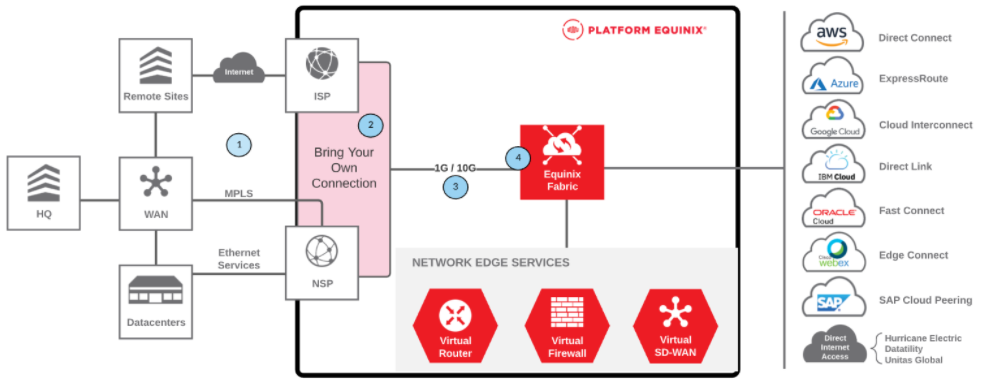The Bring Your Own Connection (BYOC) Remote Fabric Port enables Network Edge customers to physically extend their LAN or WAN into an Equinix IBX Data Center and connect to their Network Edge Virtual Network Functions (VNFs).
The ability for a Network Edge customer to leverage existing Network Service Provider (NSP) services (Multiprotocol Label Switching (MPLS), Ethernet Services (EVPL, EPL, MPLE), Optical Wave Service (OWS), and Dedicated Internet Access (DIA)) provides alternative means for accessing Network Edge. Extending the enterprise into the Network Edge with BYOC using MPLS, EVPL/EPL, OWS, and DIA increases application performance and enhances security.
Network Edge customers use the BYOC workflow in the Equinix Fabric Portal to initiate the BYOC order. The order is processed and routed across the respective Equinix teams to perform the requisite tasks to enable a Network Edge virtual connection that is built to the BYOC port.
Architecture

Components
-
Network Service Provider
-
Layer 2 Ethernet services / Layer 2.5 MPLS / Layer 3 Internet
-
NSP service provisioned as Tagged or Untagged (802.1q or 802.1ad)
-
Handoff - SMF
-
-
Network Service Provider Facilities
-
Letter of Authorization (LOA) / Channel Facility Assignment (CFA)
-
NSP tiedown location
-
NSP deployment of Network Interface Device (NID)- NSP Demarcation
-
-
Equinix Physical Cross Connect
-
Equinix IBX Technician extends physical circuit from NSP patch panel
-
1G / 10G
-
Dedicated circuit
-
-
Network Edge Remote Fabric Port
-
Physical termination of cross connect circuit to a dedicated port on the Equinix Fabric
-
Designated NSP Virtual Connection associated with Network Edge VNF services
-
Virtual Connection scalable to maximum of physical port
-
Recommendations
Once a decision is made to place a BYOC - Remote Fabric Port order, customers must:
-
Engage their respective NSPs to initiate the order process for the circuit to be delivered to the Equinix IBX Data center.
-
Initiate the BYOC order within the Equinix Network Edge Portal.
The Network Edge portal is the customer’s administrative GUI. The automated workflows initiate the BYOC order from origination to Turn-Up Call (TUC). The TUC is the last milestone in the BYOC process prior to Completion. Equinix personnel, the customer’s NSP contact, and the customer participate in a scheduled call to ensure the BYOC service is properly functioning at L1 – L3.
To ensure a timely installation, it's highly recommended that the customer work with their respective NSPs to confirm the following information before submission of a BYOC order:
-
Obtain the physical address(es) where NSP facilities reside at any given Equinix IBX Data Center.
-
Obtain the NSP provided LOA (on NSP letterhead). The LOA authorizes Equinix to perform work, and has specific tie-down (CFA) information. Incorrect information can significantly delay installation depending on NSP process.
-
Any NSP circuit can be ordered as “tagged” or “untagged”. Work with the NSP to confirm because incorrect provisioning might require a re-order of the NSP circuit order.
-
Understand the circuit delivery timeline from the NSP. This installation differs between NSPs and regions and is not specific to Equinix.
-
Work with the assigned Equinix Customer Success Manager for support and questions throughout the BYOC process.
Considerations
Diversity
When leveraging the BYOC - Remote Fabric Port, it's important to understand any diversity requirements pertaining to circuits into an Equinix IBX. Diversity considerations can range from physical circuit diversity with a single NSP, NSP carrier diversity, or transport diversity (Internet – MPLS).
Consider if the architecture design can support leveraging an NSP/ISP who is already on the Equinix Fabric, if so, time to implement and activate is significantly reduced as physical circuit installations are not required.

